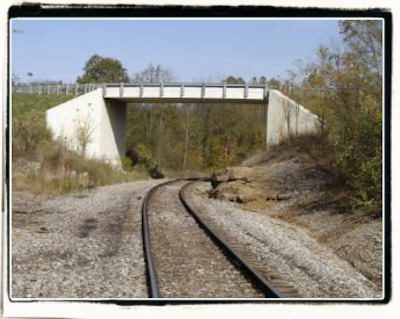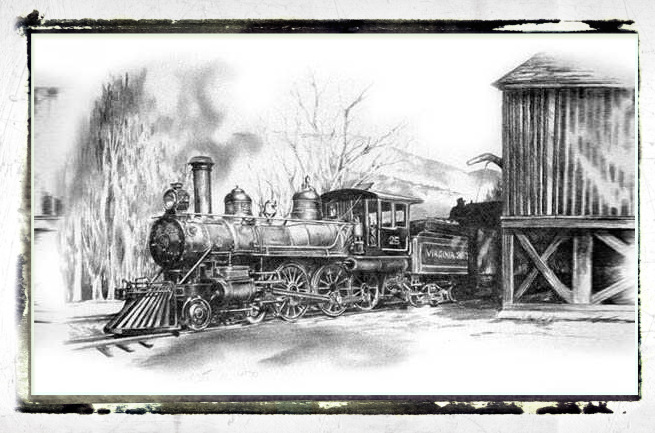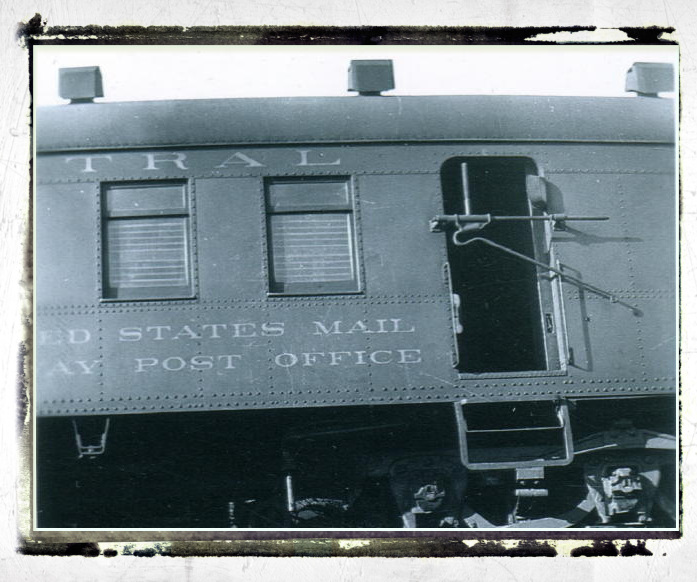|
Railroading in the Mid-Twentieth Century.
Rockport was settled along the banks of the Green River and established in 1870.
First it was river transportation and then the railroad came in. A Mainline Railroad
ran through this town, dividing it into two sections, South Rockport and North Rockport.
We always called "South Rockport" as "Cross Town". An "Overhead Bridge" that crossed
over the Railroad Tracks was the main access from one town section to the other. This
Main Railroad was the Illinois Central and rail traffic was a major means of transportation
from the original building of the railroad until somewhere around the mid seventies.
Then Illinois Central sold out and am thinking that P & L Railway now owns the
track and property.
A train crossing the Green River at Rockport, from the Muhlenberg County Side or
the West Side, would first see the track crossing, where Main Street crosses the tracks
and goes on down to the river. Next would be the Overhead Bridge. This is the view
in the picture below. After the Overhead Bridge, and just around the curve and on
the right is where the old Rockport Depot was located. The "Overhead Bridge" that is
pictured is not the original bridge, but a modern day version. The old bridge and the
one that I remember was made out of creosote timbers and large bolts, nuts and washers.
A "Railroad Crew" called a "Section Gang" was responsible for the bridges and the
rails among other parts of a railroad system. Later, this was broken up into two
gangs. These were now being called the "Bridge Gang" and the "Section Gang". Think
that it is that way today. To have known a member of either one of these gangs and have
them save you a couple of those large washers was a treat indeed. All that was needed
was two or four kids, four railroad washers and any type tool to dig a hole with.
Presto, a washer pit and kids could entertain themselves, with games and games of
"Washers". When the heat of the day put a damper on the play thing, a river was nearby.
All is given in those times and each kid would produce his bathing suit and all would
join in for a nice swim and a cooling off process. Yes, the good old days.
This stat is about this old depot and the railroad in general.

Overhead Bridge at Rockport.
Stationery by j r durham.


The above picture is a drawing of a typical train refilling area where the train engine's
reservoir is filled with water. Usually, these "Water Tanks" were located near a river
and a pumping station was used to pump water from the river to fill the water tank. When
needing water, a steam engine would stop under the fill hose. A "Ground" person could
then place the fill hose above the train's water reservoir and then pull a chain or a
lever so as to open the water valve. Water would then flow from the water tank to the
train's water reservoir and when full, the "Ground" person could close the valve and
the train could be back in operation. This water, in most cases, was not potable water,
but just plain river water. Chemicals were added to the water to prevent scale and rust
build ups. The old steam engine was mostly a boiler with the heat source in the middle.
The fireman would keep a fire going and control the heat by controlling the air flow
and the fuel flow to the boiler. This process, mostly, depended on the steam pressure
at the boiler outlet. Steam was them admitted to large cylinders on either side of the
engine. The hot steam would expand upon entering the cylinders and cause the piston to
move forward. This would move the wheels by a large crank arm. When one side of the
engine cylinder was receiving steam the other side was blocked off after it pushed the
crank arm forward and then the spent steam escaped from the cylinder as low temperature
steam and water vapor. This was the "Smoke" that was seen. After a period of time, the
water in the boiler's reservoir would become low and the train engineer would start
thinking of another depot where he could take on more water and the cycle was repeated
over and over. Wow, those were the days.
The old Rockport Depot was typical of depots in this unique period of time in American
History. A Depot Agent used this depot as his office and a control station. His
responsibility was the controlling of the tracks assigned to his area. By use of a
telegraph, each depot agent was in contact with the other depot agents and they controlled
the train traffic in their area of responsibility. A typical train would leave a central
area, for instance Chicago, and the engineer would have his orders. He may have to "Drop
Off" three loaded "Cars" at Leitchfield, pick up ten "Cars" loaded with timber at Rosine,
drop off a "Chemical Car" at Central City and pick up ten "Cars" loaded with coal and
on and on until the train reached a "Turn Around" point, for instance Atlanta. The time
of this one-way journey may be a week and would consist of several changes of "Operating
Crews". This plus, the train would take on water at several locations and may have to
take on a load of fuel. A day or so later, the process would start all over and the
trip would be back to Chicago with many stops in between. A conductor would be stationed
in a "Caboose", a small car located at the rear of the train. The conductor had his
office and communication equipment in the caboose and he was responsible for the train
and the crew. An engineer would be located in the engine room and he was responsible
for the operation and running of the train. In the same area, but on the other side of
the train engine was a controlling station where the assistant engineer worked. He assisted
the engineer and was responsible for the general maintenance of the train, like oiling
and greasing. Behind the engine was a coal car and a "Fireman" worked out of this area
and had the responsibility of stoking or keeping the boiler fire at a correct temperature
by "Firing" to control the output pressure of the boiler. In earlier days and especially
in areas where coal was not plentiful, this coal car may have been called a "Log Car"
as wood was used to fuel the boiler. Minor repair and maintenance to the train was done
in route and if needed, the train would stop along the route and "Switch" over to a
"Siding" or an alternate track, next to the main track. Here, with the train stopped,
a more serious repair could be made. Major overhaul and maintenance was done in places
called "Roundhouses". There was one located in Central City where it stayed operational
for many years. At the "Roundhouse" a train engine or a car would be placed on a "Turntable".
The "Turntable" would then turn and line up with an auxiliary rail. Now the train or car
could be moved to any of several places depending on the repair needed. If a "Wheel"
needed replaced, the car was moved to the "Wheel" shop where a large crane or lift would
lift the car and allow the old wheel to be replaced with a new wheel. Likewise, if an
engine needed to have its' furnace repaired or replaced, it would be "sided" to the
boiler shop. As you can see, this "Roundhouse" area needed to have lots of room and
different buildings and work areas. At one time, this was a big operation and employed
a hundred or so people. Sadly, all is gone now and most people may never know that
area of major activity. Those were the days.


The above picture is a "Mail Car" that was maintained by the U. S. Postal Service.
One or more postal employees would board the car in the early morning hours and have
a "Run" to make. These "Mail Cars" would be added to the train and it would leave a
certain station and continue to "Drop Off" and "Pick Up" mail at each station. This
would continue until the last station was serviced. Depending on the situation, the
mail could be "Dropped Off" in the A.M. run and "Picked Up" in the P.M. run. For instance,
a Postal Employee could board the "Mail Car" at Leitchfield to start his run. The
"Outgoing Mail" was sorted and at each "Station", a mail bag would be thrown out the open
door of the mail car. This mail would be the mail that was to be delivered that day.
This process would continue until the last station was serviced, for instance it could
be Paducah. Each station would have a "Postal Employee" that would pick up the "Mail
Bag" that had been thrown out the door of the mail car. It would be taken to the local
post office, sorted and delivered to each customer. Then, the "Outgoing" process would
start. The Postal Employee would place all of the "Outgoing Mail" in a mail bag and
transport it to the local Train Depot. They would know the train schedule and the
Depot Agent would attach the mail bag to a holder a few minutes before the train was
scheduled to arrive. This holder was positioned next to the railroad and as the train
passed, a hook would be extended from the Mail Car that would grasp the mail bag. It
would be swung to the open door of the mail car and the contents emptied and made ready
for the next station.
This "Hook" was a relatively
simple mechanism that worked with very little effort on the operators part. Notice
the vertical lever, about head high, in the above picture. This lever was unlocked
and pulled toward the operator and locked in the "Grasp" position. In doing so, the
arm with a forty-five degree finger would then be positioned horizontally instead of
vertically. At the train passed the pole where the mail bag was positioned, the mail
bag would be directed into the neck of the grasping arm on the mail car. It would
then be pulled loose from the securing mechanism of the stationery pole and now the
railroad car held the mail bag. The operator would removed the mail bag,reset the
grasping arm, and get ready for the next station. Such was life until about the middle
of the twentieth century.

Hum, looking over what has been written, leads me to believe that
I have not considered the reader and have included a lot of non-pertinent material.
Plus have not said much about the old Rockport Depot. Sorry about that. For those
that may want to look at more of this type nonsense, please stay tuned for Part 2. For
those that have tired of this rhetoric, just "Back" out and feel free to visit
other parts of the Rockport/Echols Web Site. If you are still here, thanks for
looking.


End of Part 1.
The J. R. Durham's
: < )
|
|